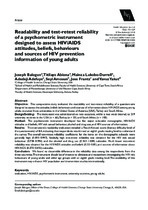| dc.contributor.author | Balogun, Joseph A. | |
| dc.contributor.author | Abiona, C. Tititlayo | |
| dc.contributor.author | Lukobo-Durrell, M. | |
| dc.contributor.author | Adefuye, Adedeji | |
| dc.contributor.author | Amosun, Seyi Ladele | |
| dc.contributor.author | Yakut, Yavuz | |
| dc.contributor.author | Frantz, Jose M. | |
| dc.date.accessioned | 2015-06-04T09:12:19Z | |
| dc.date.available | 2015-06-04T09:12:19Z | |
| dc.date.issued | 2010 | |
| dc.identifier.citation | Balogun, J. et al. (2010). Readability and test-retest reliability of a psychometric instrument designed to assess HIV/AIDS attitudes, beliefs, behaviours and sources of HIV prevention information of young adults. Health Education Journal, 70(2): 141–159 | en_US |
| dc.identifier.uri | http://hdl.handle.net/10566/1493 | |
| dc.description.abstract | Objective: This comparative study evaluated the readability and test-retest reliability of a questionnaire
designed to assess the attitudes, beliefs behaviours and sources of information about HIV/AIDS among young
adults recruited from universities in the United States of America (USA), Turkey and South Africa.
Design/Setting: The instrument was administered on two occasions, within a two week interval, to 219
university students in the USA (n = 66), Turkey (n = 53) and South Africa (n = 100).
Method: The psychometric instrument developed has five major subscales: demographic, HIV/AIDS
attitudes and beliefs, HIV risk sexual behaviour, alcohol and drug use, and HIV sources of information.
Results: The instrument’s readability evaluation revealed a Flesch-Kincaid score (literacy difficulty level of
the questionnaire) of 8.4, indicating that respondents would need an eighth grade reading level to understand
the survey. The overall test-retest reliability coefficients for the items on the demographic subscale were
generally high (0.893–0.997). Similarly, high test-retest reliability was obtained for the HIV risk sexual
behaviour (0.738–0.996) and the alcohol and drug use (0.562–1.000) subscales. Much lower test-retest
reliability was obtained for the HIV/AIDS attitudes and beliefs (0.32–0.80), and sources of information about
HIV/AIDS (0.370–0.892) subscales.
Conclusion: We found no discernible difference in the reliability data among the respondents from the
three countries. The instrument should be of interest to clinicians and researchers investigating the HIV risk
behaviours of young adults and older age groups with an eighth grade reading level. The availability of this
instrument may enhance HIV population and intervention studies internationally. | en_US |
| dc.source.uri | http://dx.doi.org/10.1177/0017896910373022 | |
| dc.subject | Evaluation | en_US |
| dc.subject | HIV/AIDS | en_US |
| dc.subject | University students | en_US |
| dc.subject | Young adults | en_US |
| dc.subject | Psychometric instrument | en_US |
| dc.title | Readability and test-retest reliability of a psychometric instrument designed to assess HIV/AIDS attitudes, beliefs, behaviours and sources of HIV prevention information of young adults | en_US |
| dc.privacy.showsubmitter | false | |
| dc.status.ispeerreviewed | true | |
| dc.description.accreditation | Web of Science | en_US |

